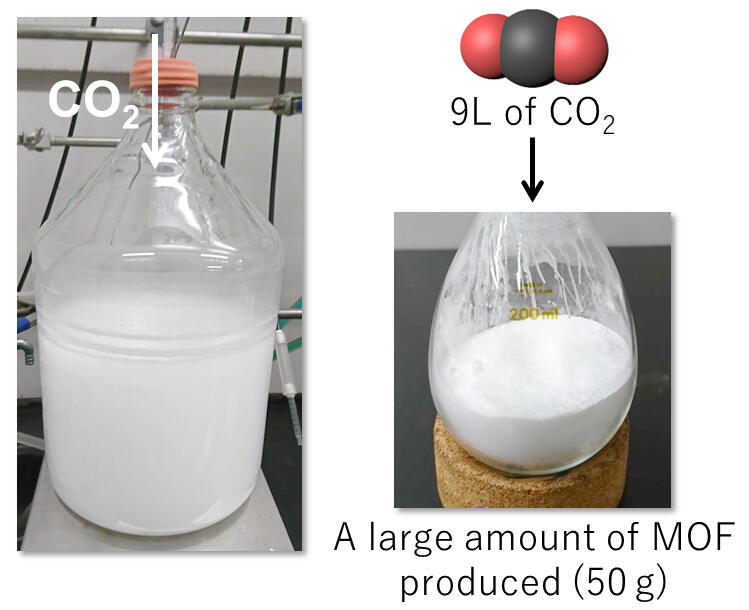There is extensive research being done into carbon dioxide (CO2) immobilization and conversion to useful resources for achieving carbon neutrality. In many cases, the conversion of CO2 into useful materials requires reactions at high temperatures and pressures and the use of expensive precious metal catalysts. This is because CO2 is stable in its most oxidized state, and so, a lot of energy is required for material conversion.
A research group comprising Satoshi Horike (an associate professor at Kyoto University iCeMS), Kentaro Kadota (formerly a doctoral candidate at the Graduate School of Engineering at Kyoto University and currently a JSPS Postdoctoral Fellow at the University of Oregon), and others in collaboration with the group comprising Yusuke Nishiyama (a unit leader at the RIKEN-JEOL Collaboration Center and an NMR application specialist at JEOL RESONANCE, Inc.) and Daniel Packwood (a junior associate professor at Kyoto University iCeMS) developed a new method for converting CO2 into a useful porous material under ambient temperatures and pressures. These findings were published in JACS.
Porous materials with micropores, such as activated carbon and zeolite are used in water and air purifiers as well as in energy storage and gas separation. The research group focused on the metal-organic framework PCP/MOF, which is a porous material with a jungle-gym-like structure and comprises metal ions and organic molecules. Since its discovery in the latter half of the 1990s, more than 90,000 types of PCP/MOF have been developed, and some of them have been put to practical use for semiconductor gas storage. However, none of these materials is made from CO2.
The research group has developed a method for synthesizing PCP/MOF by reacting organic amine molecules with CO2 and directly reacting the obtained organic piperazine molecules with a metal ion (zinc acetate). By devising a suitable combination of amines and metal ions, CO2 can be converted into various PCP/MOFs at ambient temperatures and pressures. When the obtained PCP/MOF molecular structure was investigated using synchrotron radiation X-ray diffraction measurements and solid-state nuclear magnetic resonance (NMR) spectroscopy, the results showed that uniform 1-nm internal pores were formed, and the structure comprised 33 wt.% CO2. This synthesis method works under various conditions.
For example, 9 L of CO2 can be converted into 50 g of PCP/MOF powder (80% yield) in a single reaction at 1 atm and 25 °C in 30 min. In addition, for air containing 0.04% CO2, PCP/MOF can be synthesized at 61% yield if dry air is continuously blown into an aqueous solution of amine and zinc acetate; however, it would take several days. A large amount of CO2 can be stored in the pores of the synthesized PCP/MOF. In the experiment, 1 g of PCP/MOF can store up to 0.7 g of CO2 at ambient temperature and 26 atm.

(Provided by Kyoto University)
Associate Professor Horike said, "We can now convert CO2 into porous materials by combining inexpensive metals and organic molecules at ambient temperatures and pressures. By devising a suitable combination of metal ions and amines, porous materials with various structures and functions can be synthesized and CO2 can be recycled. This method is also easily scalable, so we believe that it can be applied to fabricate CCS materials (CO2 Capture and Storage)."
This article has been translated by JST with permission from The Science News Ltd.(https://sci-news.co.jp/). Unauthorized reproduction of the article and photographs is prohibited.




